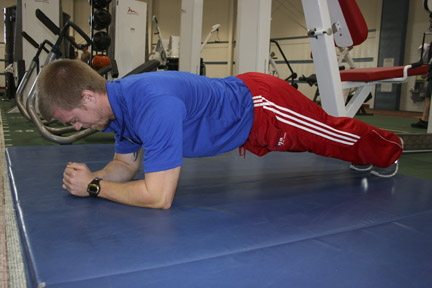Just so that we are clear,
deloading is when you reduce the volume, intensity, or frequency of training for a specified length of time. For many athletes, thinking of taking a deload week can sometimes be difficult. They are either in a groove that they don’t want to mess up, or the fear of losing too much strength or momentum can outweigh their decision to lighten up for a week. The reality of it is that they could come back the following week refreshed and more motivated than ever to reach their performance goals.
When utilizing a deload week, it can
sometimes be difficult to understand when to take advantage of it and how to modify your training so that you can come back fully recovered. Your training age, strength levels, and injury history will determine how often you need to take one. The higher your training age, the stronger you are and the more weight that you can lift. If you tend to be injured a lot, a deload week is more important if you want to be successful.
The three weeks hard, one week deload idea is something that I have added to my programs and have gotten great results from, as well. I use a four-week block system. Depending on where they are at (think off-season or in-season) will dictate if they deload at the fourth week or the eighth week.
Here I outline some general guidelines so that you can take your training and performance to the next level.
Reduce Training Volume
My first recommendation is to drop the total training volume to 60 to 70 percent of what was originally planned. To make things easy, if you had 10 total sets planned, you would only do six to seven total sets for the training session.
Reduce Training Intensity
My second recommendation is to drop the intensity to 60 to 70 percent. So here you would calculate your one-rep max (RM) and work up to only 60 to 70 percent of that 1RM. Let’s say that your bench press is 200 pounds. Then the highest weight that you would lift for the day would be anywhere from 120 to 140lbs. You can reduce both volume and intensity if you are really feeling under-recovered. In this example, if you had 4 x 5 at 80 percent of 200, you would do the following:
70% of 4 sets = 2.8
(so you would round up and do 3 sets instead of 4 sets)
Instead of doing 80% of 200, which is 160, you would complete 70% of 200, which is 140.
The athlete now would do 3 x 5 at 140 instead of 4 x 5 at 160.
Take Some Days Off or Reduce Training Frequency
The other option is to take a couple of days off or reduce the training frequency. So if you normally train five times per week, maybe come in for three days that week while dropping your volume and intensity to 60 to 70 percent. On the days off, you could incorporate some active recovery, which includes some cardiac output training (keep heart rate between 120 and 150) to help stimulate recovery, or even a mobility circuit. Again, if you are feeling very under-recovered, it might be best to take the day off completely.
Recovery
The biggest benefit from taking a deload week is to give your body a chance to fully recover so that you can stay healthy and come back refreshed and eager to train even harder. The recovery process is just as important as the training process. If you can’t recover properly, that is going to set you up for injuries.
If you take only one thing from this post, let this be your warning: Don’t wait for something bad to happen that forces you to take time off. Incorporate a deload week as part of your training program so that you can stay healthy longer. Hopefully this post gave you good insight about how to deload properly, stay healthy for a long time, and improve overall performance.
This blog was written by by Josh Jones, MS, CSCS, USAW. Learn more about the NIFS bloggers.
 groups. These exercises can range from beginner to advanced, with the functionally basic movement of sit and stand at a chair to the more challenging Burpees (add a pushup and squat jump for even more workload). The Plank exercise is also one of the best exercises for building endurance in the abs, back, core, glutes and hip flexor. To make the Plank easier add an incline or lower knees to the floor. For a greater challenge increase the period of time you hold the plank or add movement such as leg lifts or arm extensions.
groups. These exercises can range from beginner to advanced, with the functionally basic movement of sit and stand at a chair to the more challenging Burpees (add a pushup and squat jump for even more workload). The Plank exercise is also one of the best exercises for building endurance in the abs, back, core, glutes and hip flexor. To make the Plank easier add an incline or lower knees to the floor. For a greater challenge increase the period of time you hold the plank or add movement such as leg lifts or arm extensions.
 There are other “tools” you can use while on the go that you may not realize. For a cardio option, most hotels have a staircase. Use it! Avoid the elevator and take the stairs instead. For a challenge, run the stairs for ten minutes (and because most people use the elevator, it should be mostly empty for your use). Suitably known as a suitcase carry, your suitcase can be used for a one-sided farmer's carry walk that pinpoints your oblique (like a side plank), and a bathroom towel can be used to create an isometric static hold for countless upper-body exercises.
There are other “tools” you can use while on the go that you may not realize. For a cardio option, most hotels have a staircase. Use it! Avoid the elevator and take the stairs instead. For a challenge, run the stairs for ten minutes (and because most people use the elevator, it should be mostly empty for your use). Suitably known as a suitcase carry, your suitcase can be used for a one-sided farmer's carry walk that pinpoints your oblique (like a side plank), and a bathroom towel can be used to create an isometric static hold for countless upper-body exercises.





